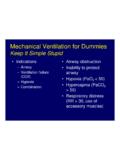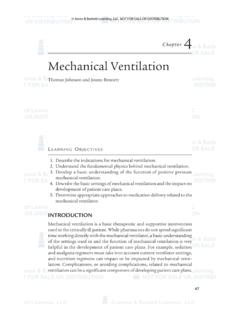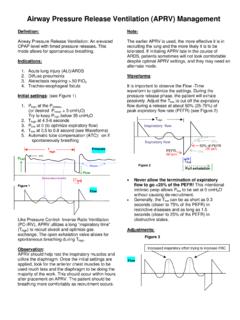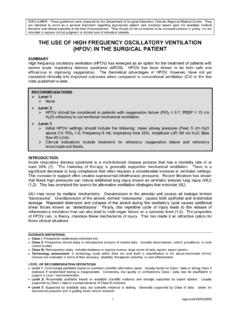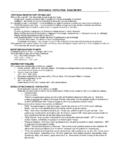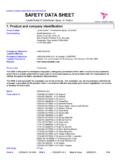Transcription of Pressure Modes of Mechanical Ventilation - || Fisionova
1 399 AACN Advanced Critical CareVolume 19, Number 4, 411 2008, AACNP ressure Modes of Mechanical VentilationThe Good, the Bad, and the UglySuzanne M. Burns, RN, MSN, RRT, ACNP, CCRN, FAAN, FCCM, FAANP Numerous Pressure Modes are currentlyavailable on ventilators. The application ofmicroprocessor technology has resulted insophisticated mode options that are veryresponsive to patient-initiated efforts, yetlittle is known about how to use the Modes ortheir effect on patient outcomes. This articledescribes a wide variety of Pressure modesincluding traditional Modes such as pressuresupport and Pressure -controlled ventilationin addition to less traditional new modessuch as airway Pressure release Ventilation ,biphasic positive airway Pressure , PressureAugmentation (Bear 1000, Viasys Healthcare,Yorba Linda, California), Volume Support(Maquet, Bridgewater, New Jersey), PressureRegulated Volume Control (Maquet, Bridge-water, New Jersey), Volume Ventilation Plus(Puritan Bennett, Boulder, Colorado), Adap-tive Support Ventilation (Hamilton Medical,Switzerland)
2 , and Proportional Assist Ventila-tion (Dr ger Medical, Richmond Hill, Ontario,Canada). The good, the bad, and the ugly issues surrounding the application, evaluation,and outcomes of the Modes are :advanced Pressure Modes , Mechanical Ventilation , Pressure Modes ofventilationABSTRACTwho manage the patients and are charged witheducating others about the application andassessment of the Modes , are unsure of whenand how best to use related to mode application is, inpart, a result of the manufacturer-selected modenames that are often different from one anotherdespite the fact that the Modes may functionquite similarly and are iterations, albeit moresophisticated and purportedly improved ver-sions, of traditional Modes .
3 This distressing factis further complicated by the tendency of theventilators to have numerous other parametersettings available for adjustmentthat have littleMechanical ventilator Modes have becomeprogressively more sophisticated withthe advent of microprocessor-controlled tech-nology. The ability of engineers and scientists todevelop ventilators that respondrapidly topatient-initiated breaths and cycle extremelyquickly between ventilatory phases hasresulted in Modes that are very attractive foruse with some of our most critically , the best use of themodes, especially as they relate to the manage-ment of the critically ill patient with respira-tory failure, has not been clearly elucidated.
4 Inthe past, volume Modes of Ventilation were thestandard, but now a wide variety of pressuremodes have emerged and are in use. Many ofthe Modes are complicated, and despite apaucity of clinical trials that demonstrate theirefficacy, proponents suggest their , bedside clinicians and APNs,Suzanne M. Burns is a Professor of Nursing in the Acute and Specialty Care Program, School of Nursing, and anAPN 2, Medical Intensive Care Unit, University of VirginiaHealth System, Box 800782, Charlottesville, VA 411 22/10/08 11:34 PM Page 399 BURNSAACN Advanced Critical Care400demonstrated scientific effect on patient out-comes.
5 Thus clinicians often feel underedu-cated about the Modes and the best use of thesame. This is unfortunate because understand-ing the Modes is essential if optimal care is tobe purpose of this article is to describeselected Pressure Modes and the science relatedto their efficacy and use. When possible, themodes are classified in categories to better illus-trate the similarities and important differencesbetween the Modes . This article discusses bothtraditional and nontraditional Pressure modeoptions such as Pressure support Ventilation (PSV), Pressure control (PCV) and Pressure -controlled inverse-ratio Ventilation (PC-IRV),airway Pressure release Ventilation (APRV),biphasic positive airway Pressure , volume-assured Pressure Modes (ie, Pressure Augmen-tation, Volume Support [VS] [Maquet,Bridgewater, New Jersey], Pressure RegulatedVolume Control [Maquet, Bridgewater, NewJersey], and Volume Ventilation Plus [PuritanBennett, Boulder, Colorado])
6 , automatic tubecompensation (although not really a mode perse, some use it as such), Adaptive Support Ven-tilation (Hamilton Medical, Switzerland), andproportional assist Ventilation (PAV). The useof the Modes from the acute to the weaningstages of Ventilation is discussed as this article, selected specificventilator mode names are referenced as repre-sentative examples of mode options in aneffort to help clarify similarities and differ-ences. It is not the intention of the author toprovide an exhaustive list of those available onall ventilators today but rather to provideinformation to the reader so that ventilatorpressure Modes and their application might bebetter Mode Characteristics:An OverviewTraditional volume Modes of Ventilation , mostnotably assist control (AC) and synchronizedintermittent mandatory Ventilation (SIMV),although still widely used are becoming lesspopular than Pressure Modes .
7 In contrast tovolume Modes , Pressure Modes were initiallyconfigured to ensure that a clinician-selectedinspiratory Pressure level (IPL) was providedon a breath-to-breath basis, volume variedwith each breath. All Pressure Modes are asso-ciated with a decelerating flow pattern dur-ing inspiration. This decelerating flow patternrepresents the speed of the gas, which is ini-tially very high but gradually lowers as thechest fills. This characteristic flow pattern isconsidered more physiologic than that associ-ated with volume-based Ventilation and maycontribute to better gas distribution as well(Figures 1 and 2).
8 2In part, it is the deceleratingflow pattern that has driven the developmentof newer and more sophisticated pressuremodes of many of the earlier ventilator models, theselection of a Pressure mode required that theclinician select the mode (ie, PSV or PCV) andthe desired Pressure level. With these pressuremodes, Pressure is stable and volume is variabledependent on compliance (lungs and chest wall)and resistance (airways). However, some newerpressure Modes require that the clinician selectfirst the mode (which may or may not have Pressure in the title) and then the relatedparameters that further define the characteristicsFigure 1:Square flow waveform: Volume breath, where the path from A to B represents insipiration, thepath from B to C represents expiration, D represents end-insipiration, and E indicates peak expiratory : INSP, inspiration; EXP, expiration; V.
9 , flow; L/min, liters per minute; S, seconds. Used withpermission from Nellcor Puritan Bennett LLC, Boulder, Colorado, part of Covidien (formerly Tyco Healthcare).AACN1904_399 411 22/10/08 11:34 PM Page 400 VOLUME 19 NUMBER 4 OCTOBER DECEMBER 2008 Pressure Modes OF Mechanical VENTILATION401of the mode such as the desired tidal volume(VT). In addition, many of the new Modes whileproviding a decelerating flow pattern, asdescribed above, may sacrifice Pressure limita-tion in an effort to ensure the desired volume. Instill other Pressure Modes , variations in bothvolume and Pressure are allowed with patient-initiated breaths during the inspiratory and expi-ratory (I/E) ventilator respiratory of these and other selected pressuremodes follow and are summarized in Table Support VentilationDescriptionPressure support Ventilation is a mode of ven-tilation that augments or supports a sponta-neous inspiration with a clinician-selectedpressure level.
10 The mode is a popular andcommonly used mode of Ventilation . Althoughinitially proposed to be a mode for weaning,PSV is also used to ventilate less stable condi-tions. This mode is available on virtually allventilators for use as a stand-alone mode or incombination with others. It is relatively easy toapply and manage because it requires fewparameter the clinician selects a PSV level, thepressure rises rapidly to a plateau (the selectedpressure) and the Pressure is maintainedthroughout inspiration (Figure 3). Termina-tion of inspiration occurs when flow dimin-ishes to one fourth of the original flow (ordepending on the ventilator, some predeter-mined diminution of flow).
